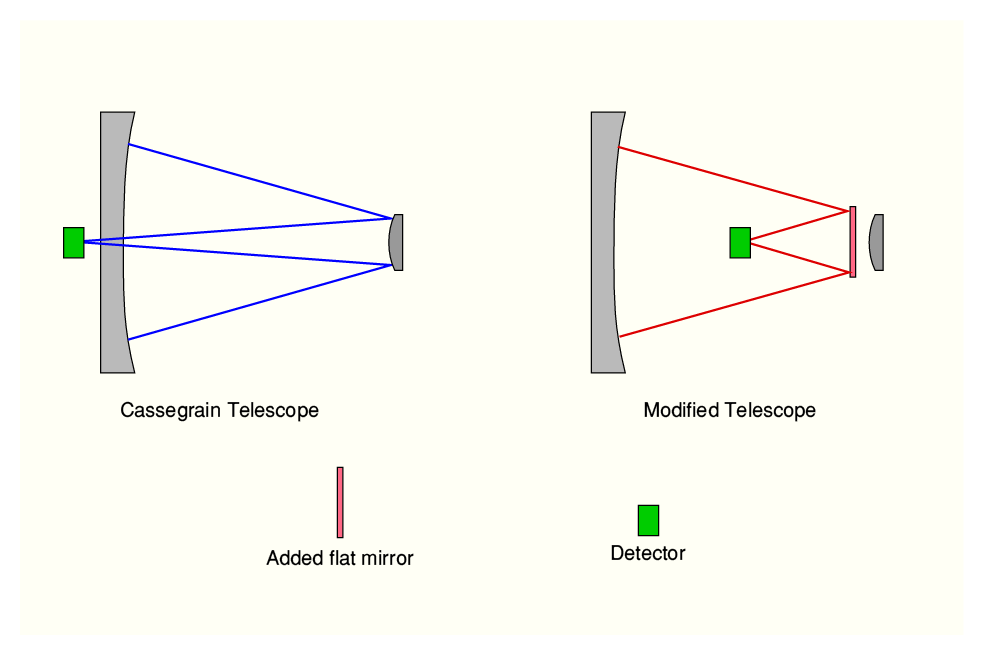
Tenerife and Telescopes
I joined the “Far Infra-Red Astronomy Group” (aka ‘Astro group’) of the QMC Physics dept during September 1972. Until that time I’d never even been on an aircraft. let alone gone abroad. However I was immediately involved in preparing for my first trip to an observatory outside the UK. The telescope in question was a 60 inch Cassegraine design that Imperial College had built at the (then) relatively new observatory site on Tenerife in the Canary Islands. At the time very few astronomical objects had been detected in the Far Infra-Red. The telescope was built for three main reasons. One being to give infra-red astronomers in the UK a telescope of their own, designed for the purpose. The second was to try out ideas for a hoped-for later telescope that would be bigger and better. And the third was to test the Teneriffe site as a suitable location for infrared observations. At the time it hadn’t been determined which locations in the world offered the clearest skies for infrared astronomy. Over later decades the work done on Tenerife contributed to the building of both UKIRT (United Kingdom Infrared Telescope) and the JCMT (James Clerk Maxwell Telescope) on Hawai’i.
My first task arose from the optics of the telescope and detector system we were to use. Photographers and astronomers will be familiar with the ‘F-number’ of optical systems. This indicate the ratio between the size of lens or mirror and its focal length. The problem was that the F-number of the Cassegraine focus of the telescope was much larger than the F-number of our detector’s field of view. As a result the combination wouldn’t work very well. However it had been noticed that the F-number of the telescope’s main mirror was almost the same as the detector. So in theory a good way to combine them was to put the detector at the ‘prime focus’ of the telescope. Alas, the practical snag was that the secondary mirror of the telescope would then be in the way! And the powers-that-be would have taken a dim view of us bashing the secondary mirror off the telescope.
Fortunately, by the time I’d joined the group a solution had been found. This was to add a temporary new secondary mirror to the telescope which would use a plain flat mirror to fold back the primary focus before it could reach the telescope’s own secondary mirror. As a result we could rig up this adaptation, use the telescope, then remove it all again once done having done no hard to the telescope itself. At least this was the cunning plan...

In order to try and keep down the cost and weight an initial idea was to try and make this new secondary out of epoxy resin. As the new boy this job was given to me. So I set about experimenting with trying to ‘cast’ suitable epoxy blanks by making them on top of a flat glass plate. The hope being that this would result in epoxy discs with a flat side we could then silver and use as mirrors. Predictably, this didn’t work because the epoxy always set unevenly, and no matter how flat the glass, the epoxy surface developed ripples. So, instead, a glass secondary was machined and, along with Tony Marston (one of the group’s technicians), I went on a trip to the Royal Greenwich Observatory to get this silvered.
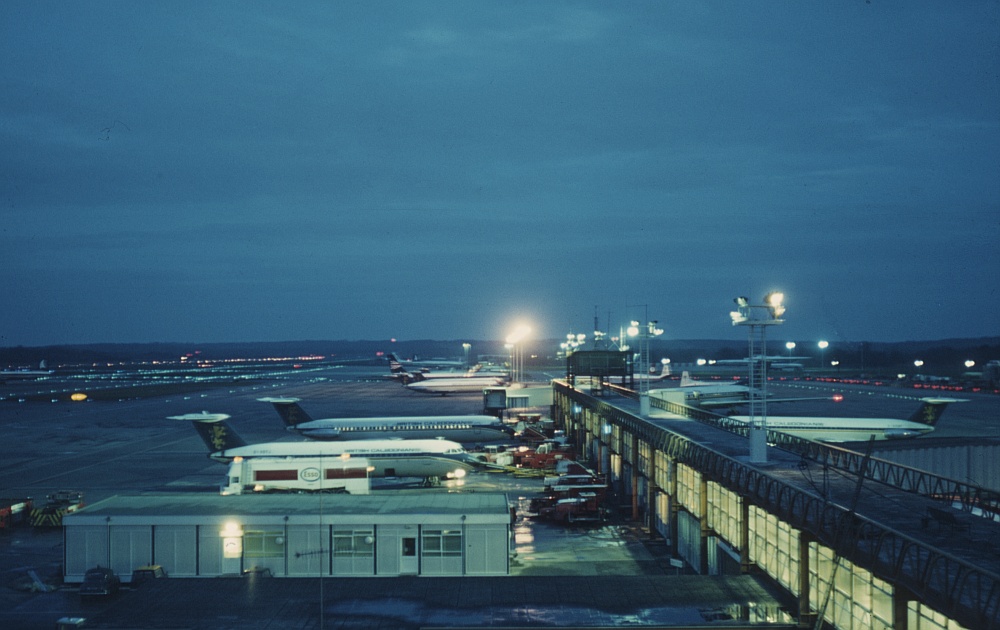
View of Gatwick airport just before dawn. |
On the 2nd December 1972 I flew down to Tenerife. This was the first time I’d ever been on an aircraft, and the first time I’d left the UK. Until then, no-one in my family had been out of the UK without being in the Armed Forces! The above photo shows the view I captured when I took a picture out of the Gatwick departure lounge window. (I held the camera against the glass to keep it steady and took a time-lapse shot lasting a couple of seconds.) At the time the British Caledonian airline used VC10 jets to run scheduled direct flights to and from Tenerife. These were ideal for London-based astronomers using the Tenerife observatory. The cabin service was often excellent – particularly during months when there were few tourists.
At the time my PhD supervisor was Prof John Bastin. He’d come up with what he thought was a nifty wheeze to save him a lot of bother, but which actually gave us grief. Normally at that time if you were ‘temporarily exporting’ equipment you had to fill out a detailed ‘carnet’ form that the Spanish Embassy then approved. Legally, the Canary Islands were a part of Spain, so this was required when taking items there. This document listed all the items and it was checked when you flew into Spain, and again when you left. The aim being to ensure you weren’t trying to smuggle goods. However John decided that since most of what were were taking was metalwork and glass we could simply carry everything in canvas bags and call it luggage.
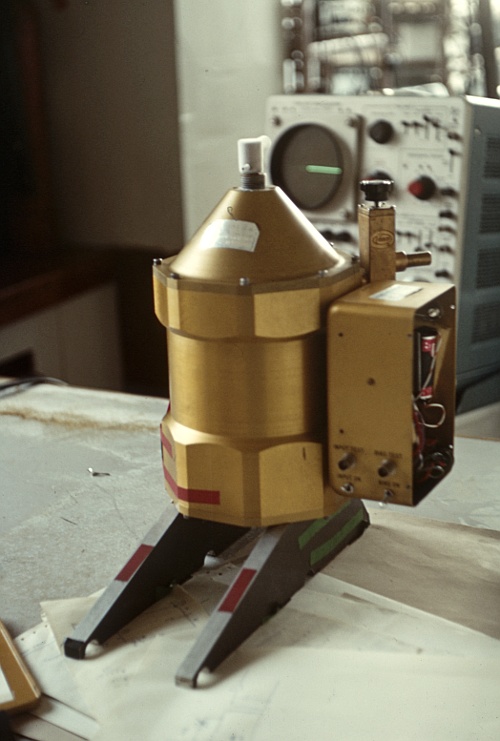
| To make life more interesting, the detector we used and took with us was in a metal cryostat. The type we used was made by Frank Low in the USA and to the untrained eye looked a bit like an antipersonnel bomb – right down to apparently having fragmentation facets! To spice this up, the makers traded under the name “Infra-Red Apparatus” and thus used to mark the cryostats ‘IRA’ in nice big letters near the top. I guess that in America this particular set of initials wasn’t quite as likely to be misinterpreted as it could be at a UK airport in the 1970s! As a result we turned up at Gatwick airport carrying large bags full of all kinds of ironware and mysterious-looking electronics. And there I was as a long-haired layabout with a duffle bag over his shoulder – out of which poked what looked like an anti-personnel bomb with ‘IRA’ prominently printed on it... Which I was taking onboard as cabin baggage.
Frankly, to this day I still don’t really know how we got away with it. However the security guards approached us and ran their hand-held loop scanners over our bags. The alarms proceeded to go bananas. They looked at us and looked in the bags. They then ran a scanner over the ‘IRA’ bag. More alarming sounds. The two guards looked at us... Then waved us though without any comment. I can only guess they looked at us and thought, “Naa. No-one would be that crazy and think they’d get away with it.” The very scale of the apparent idiocy involved on our part probably saved us from being dragged off and interrogated. |
Sadly, things went less well when we arrived at the Tenerife airport. We got off the plane and went through customs. Again the detector over my shoulder didn’t cause any concern. Maybe they’d already decided how mad astronomers were. But we waited, and waited, and waited for the rest of the bags to emerge. Finally, Tony Marston was taken into a room by one of the airport staff. They weren’t happy. I wasn’t a party to the discussions but I understand that he had to do a lot of explaining and apologising, and ended up having to pay a fair amount in duties before they would release the equipment we were importing.

Parador Hotel in Tenerife caldera |
There was no-where to stay at the actual observatory. So we lived at a Parador hotel which was located in the large volcanic caldera which occupies much of the center of Tenerife. The hotel was mainly provided for tourists, but in December it was fairly empty. The Paradors were state-owned and intended to offer visitors a high quality of accommodation that represented the best of Spanish food, culture, etc. The Parador was relatively close to Tiede so that tourists could visit the summit if they wished. The staff tended to wear local traditional costumes. Being remote, the hotel used its own generator for electricity. And this used to be turned off each evening after 10pm. So getting to or from bed at night required a torch or candle. This made getting from the bar up to your room at night a trip requiring the night-vision of an astronomer!
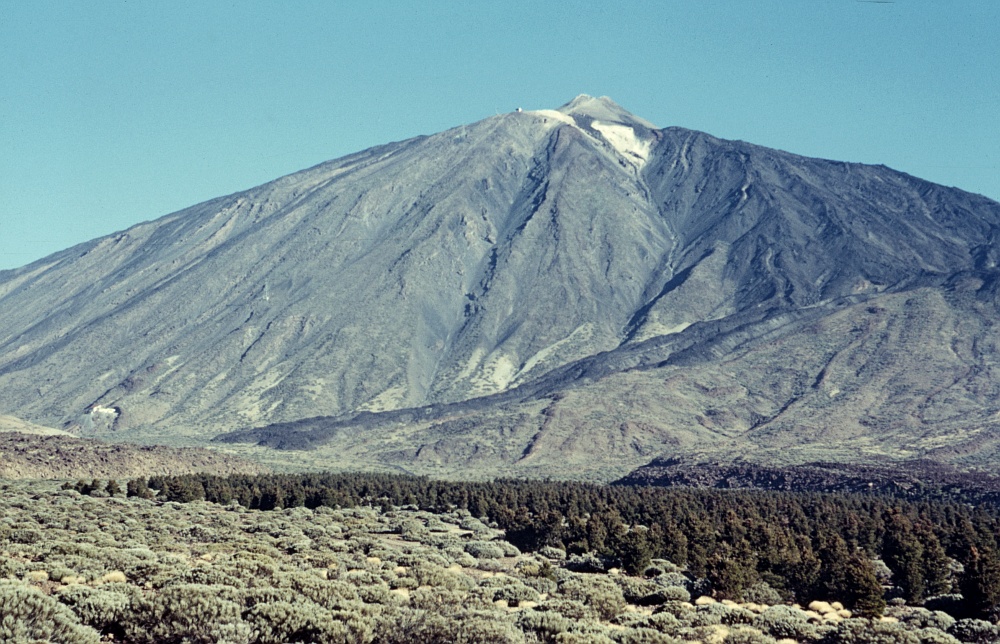
View of Tiede |
The food was excellent, and since it was my first encounter with ‘foreign’ food, a real treat. The hotel also gave a superb view of Tiede. The actual observatory was a fairly long drive away, up on the caldera rim. There were a number of telescopes, domes, and huts on the site. And at the time others were being added as astronomers made increasing use of the location. Although in time Grand Canary became the main location used for astronomical measurements on the Canary Islands.

Dome of the 60 inch telescope and its surroundings |
The above photo shows the dome of the 60 inch telescope facility. This had a workroom area attached to it and was right at the edge of the site at that time.
The quality of the roads was, to put it politely, variable. Some sections were rather narrow and winding, cut into the sides of the cliffs. However the amount of traffic was quite light. Tourists tended to stay on the coast and enjoy the beaches, sunshine, etc. It was distinctly colder up in the caldera. And the car hire firms tended to prefer their cars to not be used to drive over the interior of the island. Occasionally when driving on the mountainside roads we’d abruptly meet a large coachfull of tourists coming the other way. That could then mean some tricky reversing around mountainside curves to reach a place where we could pass by each other.
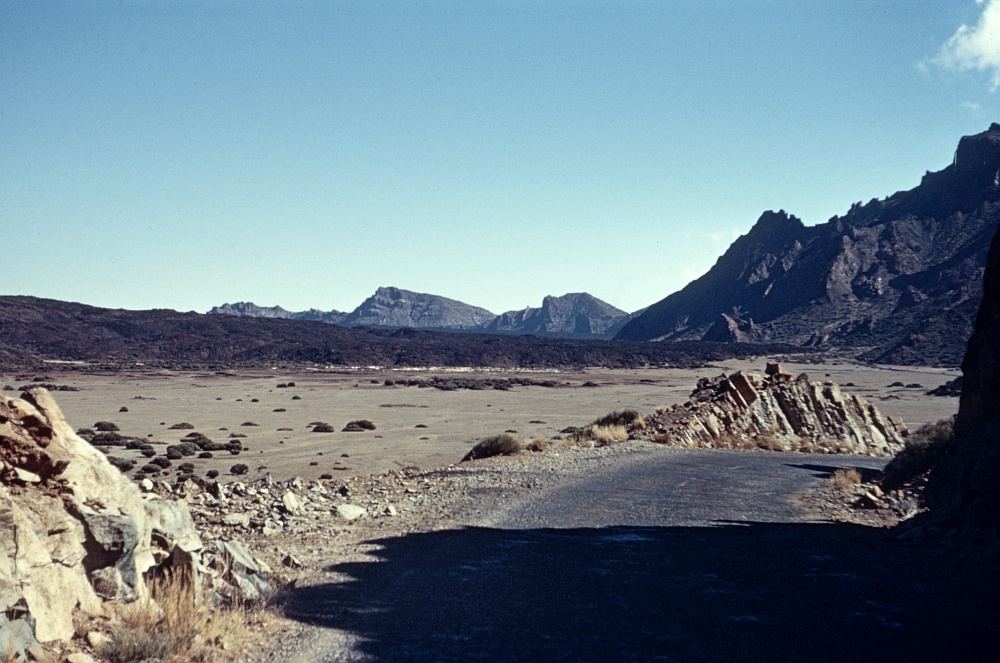
View across the caldera from the road. |
The trip was actually organised into two phases. The initial crew who flew out were myself, Tony Marston, and Nigel Cronin. Nigel was a Ph D student working for Dr Tom Philips. At the time Tom ran his own, distinct, mm-wave hererodyne astronomy group at QMC. (The astro group used ‘bolometric’ heat detectors, not hererodyne systems.) This trip was a part of the learning curve for Nigel as well as myself. The plan was that we would install the temporary secondary mirror and set things up to use our detector on the telescope. Once that was done, the second phase could begin.
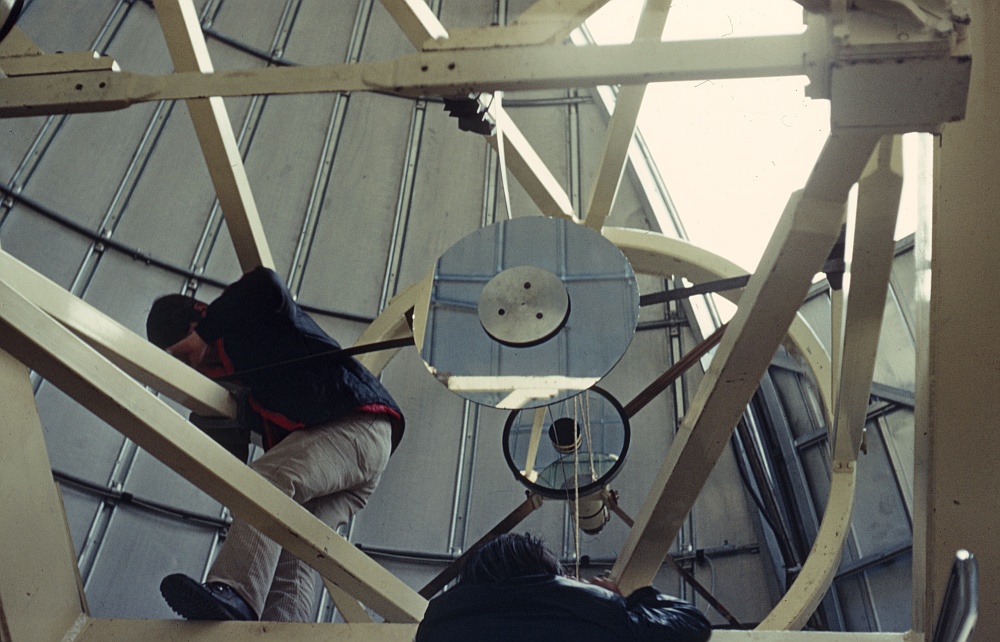
Nigel and Tony fitting the secondary mirror. |
The photo above shows Tony and Nigel fitting the temporary secondary to the telescope. From this you can see how it was located in between the telescope’s own secondary and primary (out of sight to the left of the photo). The secondary was attached via a ‘spider’ of flat thin metal beams which were clamped to the side-beams of the telescope cage.
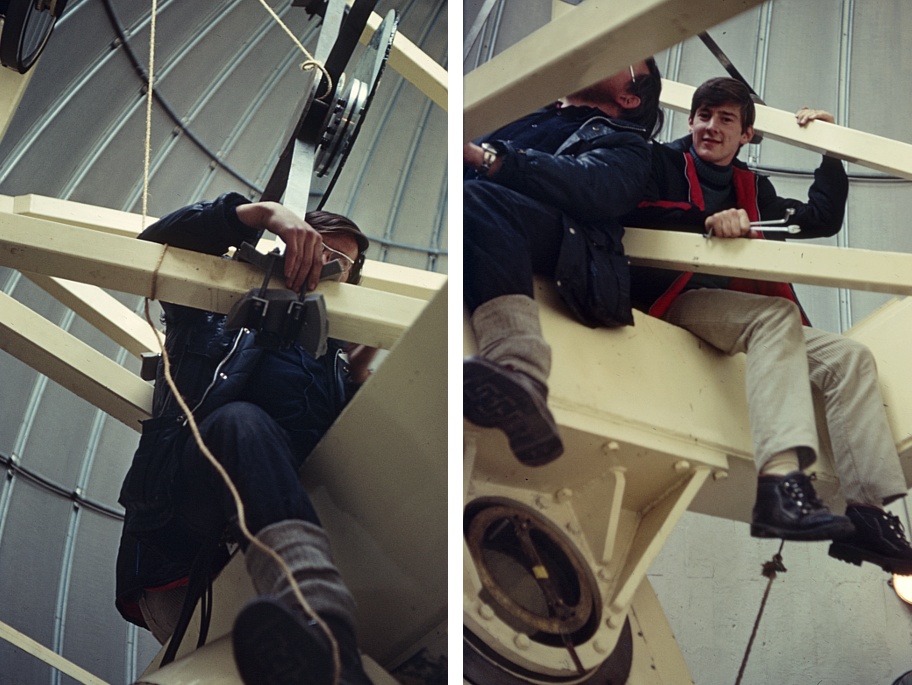
Tony (left) / Nigel (right: wearing his flameproof socks.) |
The detector also had to be mounted in front of the primary mirror. This was less than ideal. But it had to be relatively close to the added secondary. The photo, below, shows the detector above the main mirror. The sheets of black plastic are actually the same material used for dustbin liner bags! The black plastic covered over the primary whenever we used the telescope in the daytime. This was because although the primary wasn’t flat enough to act as a high quality telescope in the visual region it still would focus the light to a fairly small disc at its focal plane. The problem with this was there was a risk that, during daytime, it might focus the sunlight and produce a ‘hot spot’. The sheets of black plastic stopped the visible and near-Infrared light from getting to the mirror. But were almost transparent at Far-Infrared wavelengths. So solved the problem whilst allowing us to use the telescope for observations.
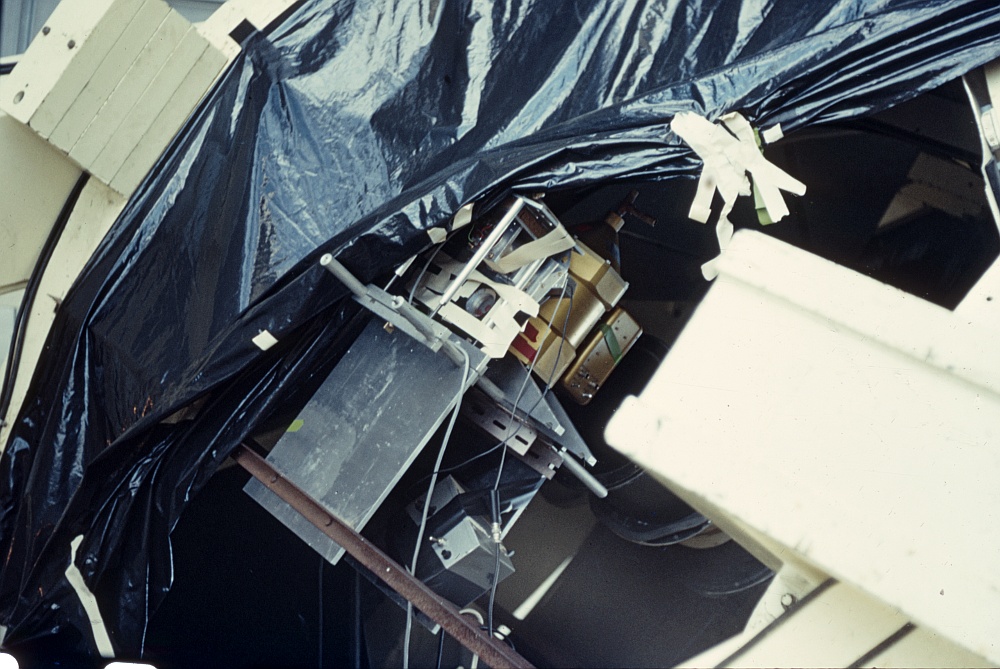
Detector mounted on telescope just above the primary mirror. |
Amateur astronomers are warned about this because accidentally looking at the sun though a telescope is likely to damage eyesight. However, professionals using large diameter telescopes also have to worry about causing a fire or seriously damaging equipment. (In reality, many professional astronomers rarely look though a large telescope, anyway. They tend to use finder telescopes, cameras, etc, instead.) I know of one case of an eminent IR astronomer who shall remain nameless who allowed sunlight onto the mirror of a large telescope. The result was a scar along the inside of the aluminium dome where the focussed spot had melted the metal. This had dripped onto benches and started a fire. Fortunately, this was put out with no further damage. But it was a cautionary reminder that a large telescope has to be used with due care!
The detector required a supply of liquid Nitrogen and liquid Helium as it had to cooled down to around -270 degrees Celsius to operate correctly. The problem was that there was no source for liquid Helium on Tenerife. Back at QMC we had our own liquifiers. But any liquid helium had to be transported by ship from elsewhere to Tenerife.
This was sent out on a ‘Fred Olsen Line’ ship. Along with that the group’s own motor van was shipped. The van was a Commer kitted out as a travelling home. i.e. it had a basic cooker, sink, places for sleeping bags, etc. The liquid Helium was sent in a 100 litre dewar shaped as a large vertical cylinder with rounded ends. This was stood on a set of small wheels to move it about, and the access vents, valves, etc, were on the top. These dewars needed to be treated with care as they were essentially a very large delicate ‘vacuum flask’. Heat would slowly seep into them and this caused the Helium to gradually boil away. They were very well insulated, but after many days at sea would tend to only be about 60% full by the time they arrived.
It was vital that the gas produced by the slow boil was able to escape via a small valve at the top of the dewar. If this didn’t work, the pressure would build up and the dewer would eventually explode! Similarly, if the valve or pipes were too far open, water might get into them and freeze solid into an ‘ice bridge’ – blocking the pipes. This could also lead to an explosion. The usual remedies for this were to initially try repeatedly lowering a long warmed rod of metal into the pipe and try to melt the ice bridge. When this happened it could release the pressure, but might violently eject the metal bar like a javelin. If this didn’t work or the pressure was too close to an explosion, the recommended action was to put the dewer in a field as far as possible from anyone, and if necessary shoot at it to cause it to explode where it would do minimal harm.
Given that we all knew this you can imagine our reaction when we went to the port to collect the dewar and the cargomen there proceeded to roll the dewar out of the warehouse and towards us on its side! Hard to decide between ‘brave Sir Robin’ – run away, run away! – or to shout at them to stop. But we stopped them, checked the valve and righted the dewer. Fortunately, it wasn’t excessively overpressured. But had probably lost rather more Helium than usual...
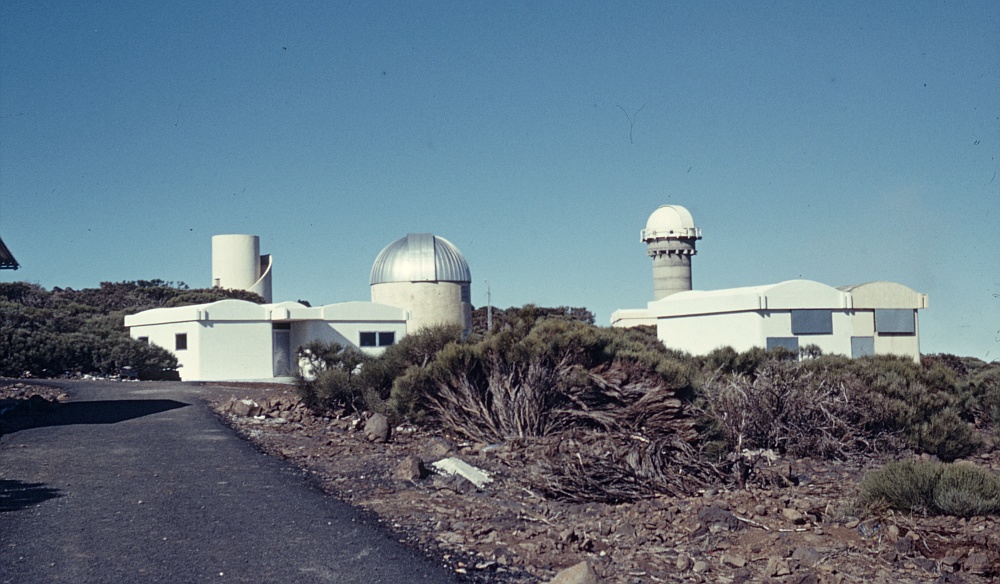
General view of observatory taken with 60 inch dome behind me. |
Above is a view of the observatory site, including one tower which was unfinished at the time, awaiting its dome and telescope. The other telescopes were higher up, nearer the top of the rim than the 60 inch.
Once our temporary secondary and detector mounting were installed we went onto ‘phase two’ of the trip and started to try to make some astronomical observations. Predictably, this ran us into more snags. Two problems in particular kept arising. The ‘main’ problem (pun alert!) was with the electricity supply and the electronics that was used to drive the telescope and report where in the sky it was pointing.
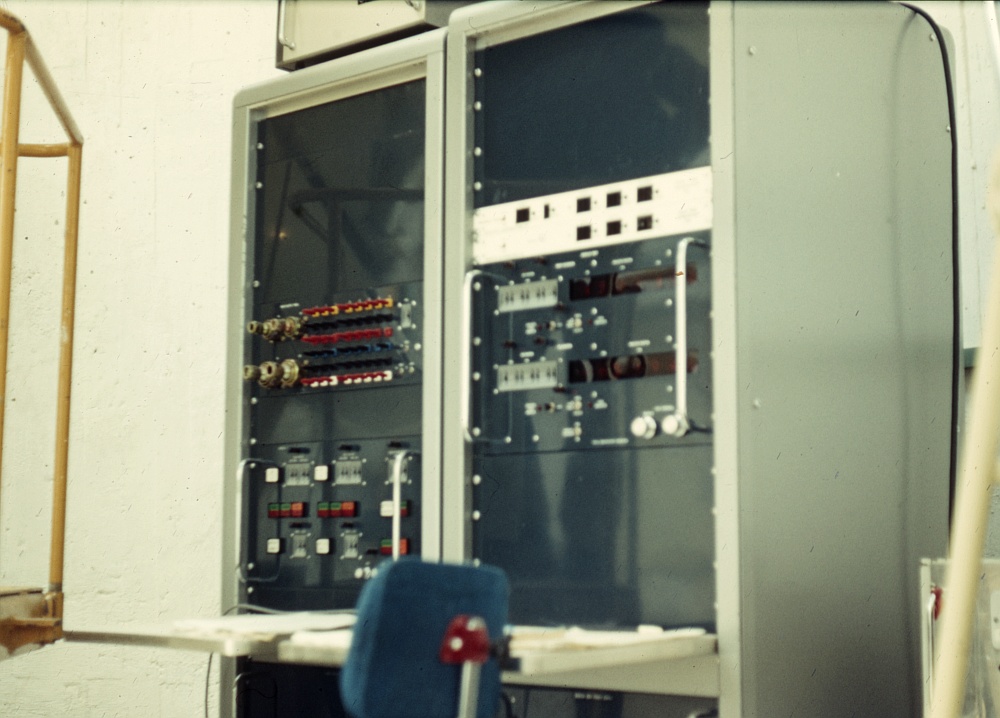
Telescope control electronics in 19 inch rack units. |
The telescope control system was housed in a couple of 19 inch rack units. The system had been designed and built back in the UK at Imperial College. There it probably worked fine. But on Tenerife it had a fatal weakness... The telescope used a couple of shaft encoders to indicate the direction in which it was being pointed. As the telescope moved these sent electronic signals to the rack units and the direction (declination and Right Ascension) values were shown on some numeric displays which you may just be able to see in the above photo. However these encoders were ‘incremental’. i.e. The electronic signals didn’t specify the actual direction, but simply indicated what change was being made. i.e. as the telescope moved they sent a stream of pulses that were ‘clocked’ by counters in the rack unit, causing the displayed values to rise or fall according to the direction of movement.
For the designers that would have seemed a perfectly sensible approach. Unfortunately at the time the mains power for the dome came from a TV transmitter station some way from the observatory. And this mains supply was intermittent. Hence every now and then the mains power would fail, then reappear. Frustratingly, even a brief ‘drop out’ caused the values shown on the rack units to become zeroed whatever actual direction the telescope was pointing at the time! This happened quite often and on every occasion we then had to spend a lot of time recalibrating the values... only to hit the same problem again. One consequence of this was a lot of dark and expletive-loaded comments about the ‘Spanish Main’.
At the time the QMC Astro Group had two lab technicians – Tony Marston and Derek Vicars. Derek was the man to go to if you wanted some mechanical system carefully designed and superbly made. A craftsman. However Tony was quite different. He was an ace bodger. He could fix anything by coming up with some ingenious way around such problems. Hence he was the perfect choice to take on an observing trip when almost anything can go wrong and you need a quick solution. After a few days of cursing he drove down to the coast and returned with a couple of large metal protractors. Then he fixed them to the telescope and added some weights on string to act as plumb bobs. The result was that we then had some ‘absolute’ indicators of the angles. These were only accurate to a degree or two, but much better than being totally lost. So they made life much easier.
The second problem was that the telescope wasn’t really correctly balanced. The basic system was that a synchronous motor would run continually, causing the telescope direction to move and compensate for the rotation of the Earth, keeping the item being observed in view. This motor drive went via a clutch for two reasons. One was to avoid overloading the motor if something went wrong. The other was that to adjust the direction of pointing there was a long rod sticking out of the back of the primary mirror support. This had a grab-handle at the end. When you wanted to move the telescope you grabbed the handle and did this by hand – or rather by arm! The clutch then slipped to allow this to occur without damage to the motor.

Hang John Long here! |
Provided we were observing an astronomical object that was rising in the sky the telescope would ‘track’ it OK. However as an object started to set the telescope’s clutch would begin to slip, and tacking would be lost. At that point we realised the meaning of something we’d seen written on the telescope when we arrived. (Shown in the photo, above.) Clearly, previous users had encountered the same problem! The eye-bolt pointed to beside the text, “If drive slips, hang John Long here”, was located where it was possible to hang a weight that would tend to apply a torque that pulled the telescope in the direction of continuing to track. However we didn’t manage to find any suitable weight that did this without causing other problems. So in the end we simply tightened up the bolts that spring-loaded the clutch – thus causing it to grip more firmly. At the time we planned to slacken these again when we departed so no-one would know we’d been naughty.
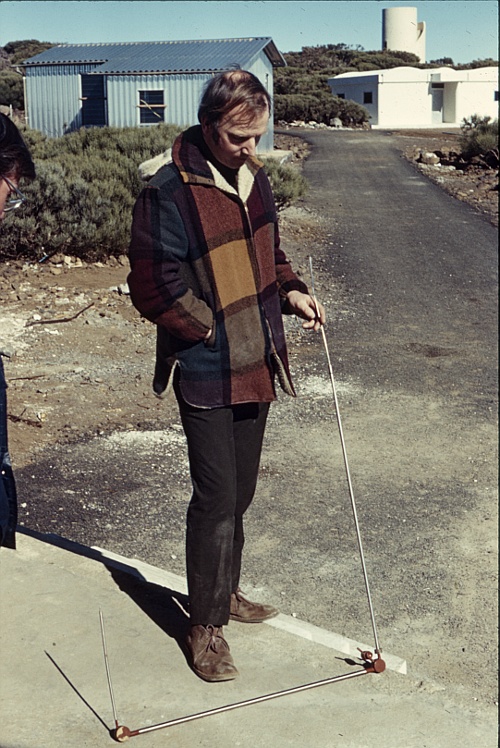
|
The photo to the left shows my then-supervisor, Prof Bastin helping to ‘dry out’ a helium transfer tube. Alas, as anyone familiar with using liquid Helium will probably recognise, he is showing everyone the wrong way to do this. Maybe it was the effect of altitude upon the Professorial brain. The transfer tubes have a vacuum ‘jacket’ to help prevent the Helium boiling away before it can get from one end to the other. When possible a transfer should start by blowing some Helium gas though the tube to expel any air or water vapour.
Similarly, when a transfer ends the tube should be stored as an ‘inverted U’ to try and prevent water for condensing in the very cold inner tube and collecting there. Otherwise there is a risk of an ice bridge blocking the tube. However there is a tendency for this to happen simply because the inside is so cold that it will draw in air and water as it warms up. Once this occurs you need to blow dry (preferably warm) air or Nitrogen gas though the tube to dry it out. Sadly, the photo shows John warming up a cold transfer tube in a way that would encourage water to get into it and collect in the tube. |
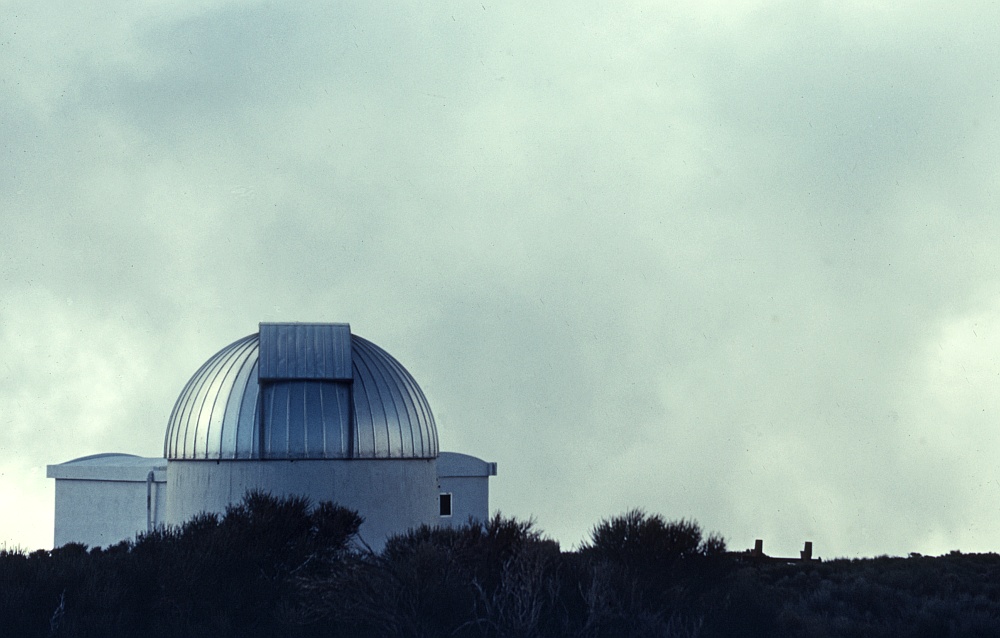
View of the 60 inch dome from higher up the caldera rim. |
The technique is to keep altering the direction in which the telescope is pointed so it alternates between looking at the wanted source and at a point just a small angle away from it, taking it out of view. This gives you some ‘on source’ and ‘off source’ measurements. You then subtract the ‘off source’ measurements from the ‘on source’ ones and the result tells you how much is actually coming from the source. This isn’t ideal because the direction that is ‘off source’ might differ in some other way. But in general it works fairly well. A snag is that the behaviour of the atmosphere fluctuates randomly as time changes. So in practice you have to keep switching between ‘on’ and ‘off’ and record a series of such measurements to then do some statistics on the values.
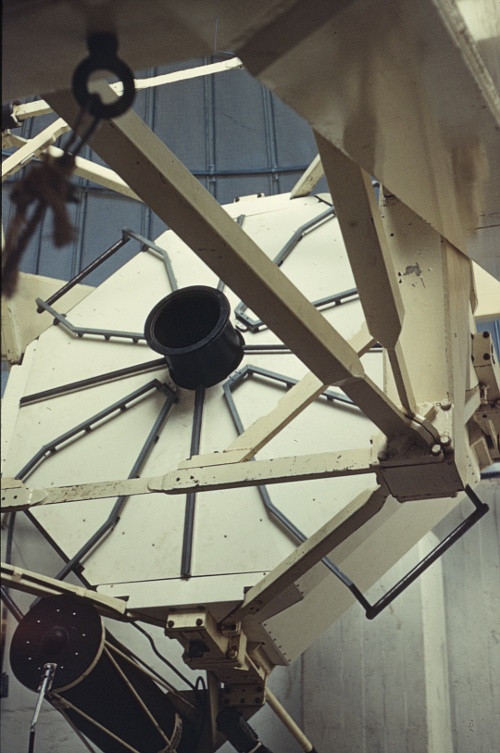
60 inch primary with covers protecting the mirror surface. |
With the 60 inch telescope and the system we had this process was somewhat laborious. The telescope was moved ‘on’ and ‘off’ using the large hand lever at the back. The photo above shows the primary mirror of the 60 inch telescope with its covers closed. (This photo was taken when our equipment weren’t mounted onto the telescope.) At the bottom of the primary main mirror you can see the finder telescope and other items. You can also just see a tubular metal rod sticking out from the telescope, parallel to the optical axis. This is the rod onto with a ‘grab handle’ was attached (just out of view in the photo) to allow the user to drag the telescope around and change where it was pointing.
During each observation a value appeared on a Digital Voltmeter (DVM), and was written down. The grab handle was then used again, and the next value written down. This process was then repeated many, many, many times, as a long series of pairs of ‘on’/‘off’ values were written down. So after, say, half an hour, someone (i.e., me) would then sit down and – by hand – work out the calculations to get the answer. All done by pen-and-paper methods and mental arithmetic on literally hundreds of numbers covering many pages of a notepad. Not to mention done in the freezing cold with low atmospheric pressure and lack of sleep adding interest to the process!
Anyone reading this nowdays may find this a bit strange. But remember this was an age when none of us had hand calculators or ‘personal computers’ of any kind. Even the DVM we used was a large, heavy, 19 inch rack unit item which had a set of mechanical wheels inside that clattered around when the values changed. Each wheels each had a set of numbers on them to be able to indicate a digit of the value to be shown. The result was a sort of ‘fruit machine’ and the pattern of where the wheels stopped showed you the ‘prize’ – i.e. the actual value. There were calculators, but of the kinds you might see now in a museum. Mechanical types where you rotated a handle and the complex mechanism did its work. The closest we had was a slide rule and printed tables of log, sine, etc, values. Quite a contrast with modern professional astronomy where an astronomer in the UK can go to their university office during their normal daytime hours and use their computer over the internet to control a telescope in Hawai’i from the comfort of their office!
Fortunately, I had an interest in electronics and had already done an undergrad course in the new-fangled digital electronics. TTL (Transistor-Transistor Logic) integrated circuits were just coming into use. I quickly decided that it would make sense to automate this tedious process of telescope control and data collection/processing. A lesson ground into me by the tedium of spending hours moving a telescope ‘by hand’,writing down pages and pages of numbers, and then doing pen-and-paper arithmetic on them. However this introduction didn’t bear any fruit until later projects.
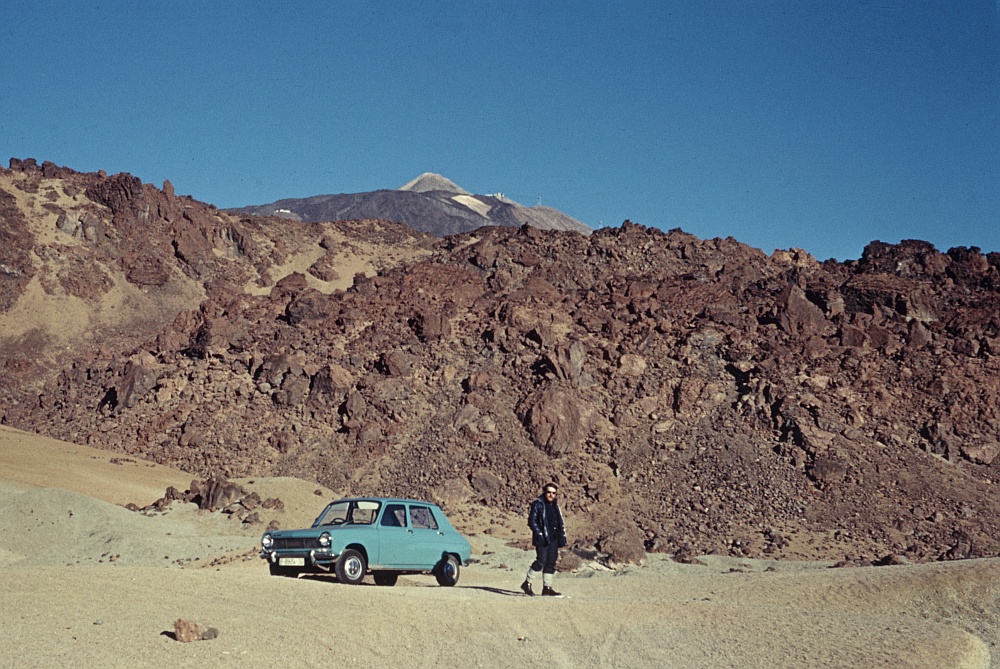
Tony and hire car on caldera during first phase of trip. |
The original plan was that during the last few days of the trip we would remove the added secondary, etc, and pack them into the Commer van for return to the UK. Whilst working at the observatory we’d tended to use the van as an added ‘living accommodation’. In the main this meant we could use it to make tea, coffee, or tomato soup as hot drinks. But once done the idea was to use it as a packing case to get the kit home. However during the last few days as we removed the equipment from the telescope a storm arrived. Lots of high winds and snow at the summit. More winds and heavy driving rain at lower levels. So we decided that discretion was the better part of valour and decided to emulate ‘Brave Sir Robin’ and... depart early. Hence we got into the van and tried to drive down the mountain before being snowed in.
The trip down the mountainside roads was fairly ‘interesting’. The winds kept blowing the van sideways. Not much fun with a cliff face on one side of the winding road and a sheer drop at the other. The Spanish habit of painting a white cross on the road in places where there had already been a fatal accident didn’t lighten the mood, much, either! Another diversion was that the van’s headlights weren’t in perfect working order and by now it was dark and snowing. The problem was that one of the headlights occasionally would go ‘dipped’ and needed a swift kick to make it come on full-beam again. Tony was driving – good news as he was an excellent driver – so my job in the front passenger seat was to deploy a swift boot when needed so he could continue to see where we were going.
Eventually we had driven down to a level where we into rain rather than snow. But we then came to a large tree across the road. This was too big to move easily, and it was dark, pouring with rain, and with strong gusty winds. So we discussed what to do. Finally we drove back up the road a short distance to what seemed a better location and parked for the night, hoping we could sort things out the next day. We then spent an uncomfortable night trying to sleep in a cold van being shaken around by the wind and lashed by the rain.
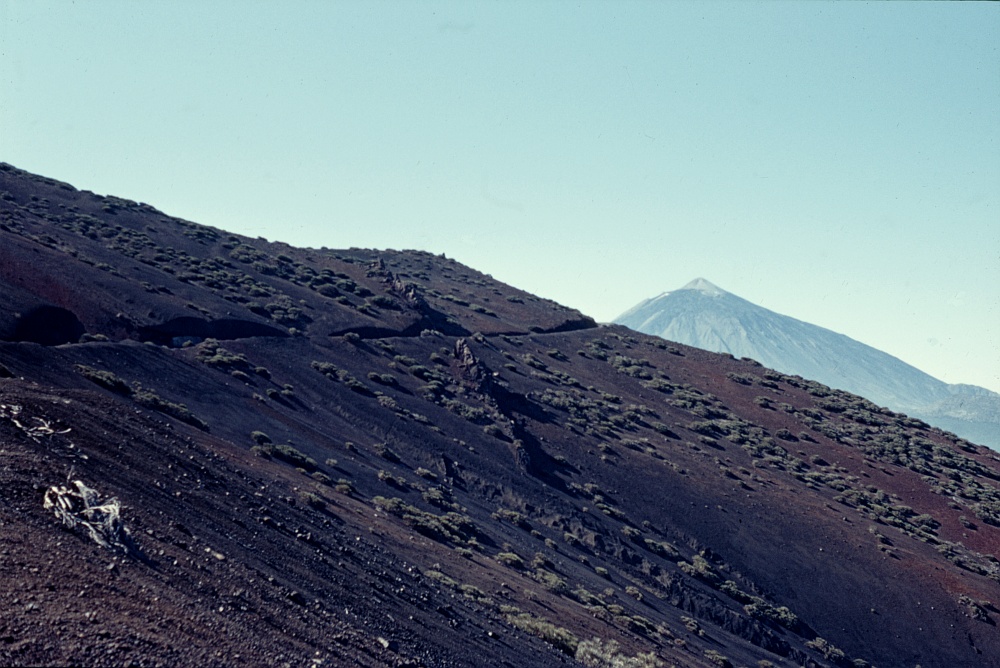
View of the road on the side of the caldera rim. (Also taken during the first phase of the trip.) |
When we got out of the van the next morning we discovered that it was now much closer to the sheer drop at the side of the road than when we’d stopped. The winds had been so strong that they have rocked the van around, closer to the edge. However we were still OK. And the storm had largely passed. Fortunately, when we looked, the fallen tree had been moved as well, and had gone down the mountainside. We didn’t have much time left, so drove down to the airport and left on time.
The problem then was that because of the rush we’d left some of the equipment behind. And fresh documentation would now be needed to get it back from Spain to the UK because our original documents lapsed when we came home. As a result on a later trip we took an item of equipment we referred between ourselves as a ‘geranium detector’ so that something with this name would be on our new paperwork. The name was was actually a spoof on ‘Germanium’ which was used for some types of infra-red detectors. but in reality the object we took was a short length of large diameter pipe with a flat plate bolted to each end. We took that with us, and left it at the observatory, bringing home the actual detector we’d had to abandon, now covered by our fresh paperwork.
Overall, an interesting introduction to the strange world of Far Infra-Red Astronomy of the period. I imagine – or at least, hope – observing trips are rather more organised and less wild and woolly these days. However during my first year as a postgraduate student John Bastin became head of the QMC Physics Department. As a consequence of this he had less time for student supervision. This, combined with my interest in automating the processes of data collection, system control, etc, prompted me to switch to working with another member of the group. This was John Beckman, and that in turn lead to my becoming involved in using Concorde 001 to observe the 1973 Solar Eclipse...
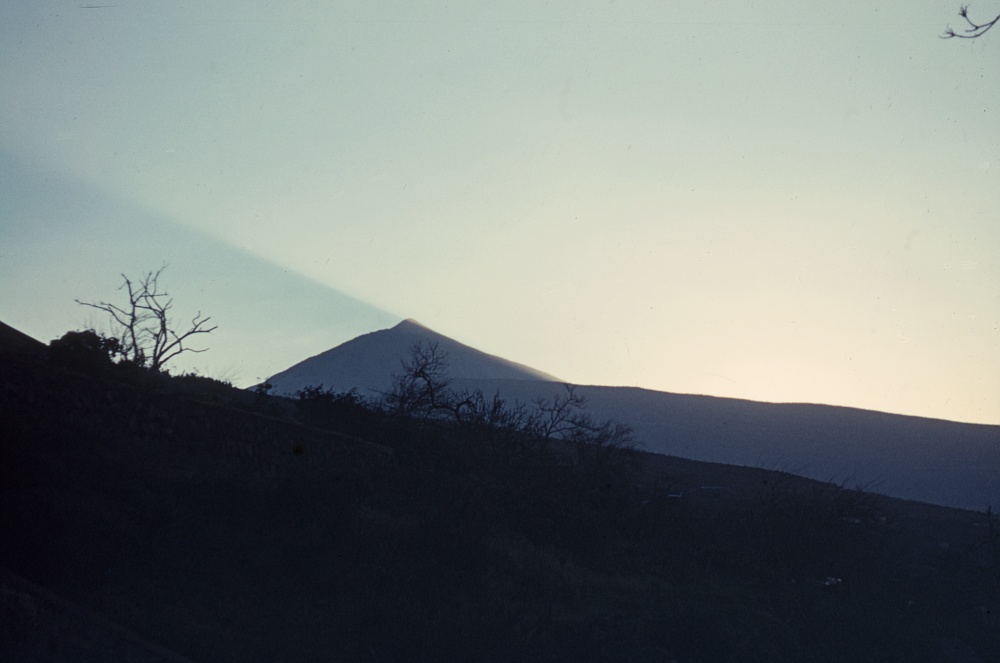
Tiede sunset |
The above is a sort of ‘farewell’ photo of Tenerife which shows Tiede at sunset with its shadow across the sky. Sadly, the fact that you can see this shadow tells you the air isn’t necessarily crystal clear. So although a pretty view, it isn’t what astronomers would like to see. That said, I must add that my first few nights up a caldera level on Tenerife were the first time I’d really seen just how many stars could be visible from the Earth! During the initial phase of the trip we’d worked in the daytime and gone back to the Parador for food and sleep. This let me take a walk away from the hotel lights and look up at a cloudless night sky. I’m not an amateur astronomer and don’t know the constellations very well. But I was normally able to recognise the Plough (Big Dipper), Orion, etc. However looking up at night I discovered I could see far more stars in the sky than I’d ever seen from the UK. Intellectually, I knew the urban lights and cloud in the UK reduced what I could see. But until that moment I had no idea just how much they hid from view. Up at some altitude on Tenerife the view was stunning. For the first time in my life I saw the Milky Way with my own unaided eyes, reaching right across the sky above me. So many stars that they swamped the constellations I was used to beyond my ability to find them. Overwhelming.
Oh, and in the rush to get away and avoid the storm we forgot to slacken off the telescope’s clutch. As a result there were, apparently, some ‘difficult’ telephone conversations between John Bastin and the telescope designers when they found out what we’d been up to and expressed their displeasure. However it didn’t seem to prevent us from continuing to use the telescope for later trips. I can’t recall if we removed the protractors, though. Maybe Imperial College nicked them!
5600 Words
Jim Lesurf
23rd Jun 2017